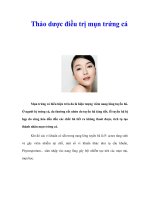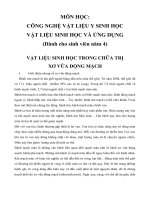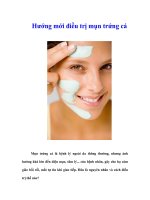DermFactor VẬT LIỆU SINH HỌC ĐIỀU TRỊ VẾT THƯƠNG, LOÉT, PHẪU THUẬT CẮT TRĨ
Bạn đang xem bản rút gọn của tài liệu. Xem và tải ngay bản đầy đủ của tài liệu tại đây (171.83 KB, 4 trang )
International Journal of Surgery 52 (2018) 229–232
Contents lists available at ScienceDirect
International Journal of Surgery
journal homepage: www.elsevier.com/locate/ijsu
Original Research
The clinical application of a silicate-based wound dressing (DermFactor®) for
wound healing after anal surgery: A randomized study
T
Shuo Chena,1, Zhiguang Huanb,1, Lin Zhanga,∗, Jiang Changb,∗∗
a
Department of Anorectal Surgery, Tianjin Union Medicine Centre, 190 Jieyuan Road, Tianjin 300121, China
State Key Laboratory of High Performance Ceramics and Superfine Microstructure, Shanghai Institute of Ceramics, Chinese Academy of Sciences, 1295 Dingxi Road,
Shanghai 200050, China
b
A R T I C L E I N F O
A B S T R A C T
Keywords:
Silicate-based wound dressing
DermFactor®
Anal surgery
Wound healing
Background: The object of the present study is to evaluate the feasibility of a silicate-based wound dressing
(DermFactor®) in treating the wound of the patients after anorectal surgery.
Materials and Methods: The present study included 328 patients who received anal surgery during the period
from March 2013 to June 2015. The patients were randomized to 2 groups. The patients (n = 162) in the control
group received conventional dressing therapy, while those in the observation group (n = 166) were treated with
the combination of conventional dressing therapy and the use of a silicate-based wound dressing (DermFactor®).
The wound healing outcomes of the two groups were observed and compared with each other by statistical
analysis.
Results: The average healing cycles in the observation group were 19.04 days for combined hemorrhoid patients,
23.72 days for anal fistula patients and 21.14 days for anal fissure patients, respectively, which were shorter than
those in the control group (23.25 days for mixed hemorrhoid patients, 27.76 days for anal fistula patients and
24.32 days for fissure in ano patients, respectively). In addition, the observation group presented a significantly
higher effective rate (80.4%) than the control group (70.4%).
Conclusion: Our data demonstrated that the wound after anorectal surgery could be more effectively treated by
using silicate-containing DermFactor®.
1. Introduction
Anal diseases, including hemorrhoid, anal fistula and anal fissure, is
common all over the world and affecting people in all age groups [1,2].
The patients suffering from these diseases frequently require surgical
treatment, and the post-operative care has been considered as one of
the most important factors that determine the cosmetic and functional
outcome of the anal organ. [3]
Wound healing is an essential step during the procedure of postoperative care after anal surgery [3]. For example, it is believed that a
desirable wound healing could help reduce the post-operative pain after
haemorrhoidectomy, which quite commonly causes delayed patient
discharge [4]. However, due to the unusual circumstance, the wound
healing after anal surgery is frequently delayed by postoperative complications, such as bleeding, infection and edema, despite the use of
wound healing cream. Therefore, it is still necessary to investigate more
efficient therapeutic regimen to accelerate the postoperative wound
healing after anal surgery.
DermFactor® is a silicate-based wound dressing that has been widely
used for wound treatment in cases of burn, diabetic foot and bedsore
[5], and its bioactive effect on wound healing is based on the fact that
silicate materials can stimulate the vascularization that is essential for
healing of soft tissue [6]. This important feature makes DermFactor® a
potential candidate as a wound dressing to accelerate wound healing
during the postoperative care after anal surgery. Therefore, during the
period from March 2013 to June 2015, DermFactor® was used to treat
166 patients, who received anal surgery, aiming at improving the
wound healing. This study presented the clinical outcome of the application of DermFactor® as wound dressing for anal surgery, and also
evaluated its benefit in terms of wound healing rate and efficiency.
∗
Corresponding author.
Corresponding author.
E-mail addresses: (L. Zhang), (J. Chang).
1
The two authors contributed to the work equally.
∗∗
/>Received 30 August 2017; Received in revised form 4 February 2018; Accepted 14 February 2018
Available online 23 February 2018
1743-9191/ © 2018 IJS Publishing Group Ltd. Published by Elsevier Ltd. All rights reserved.
International Journal of Surgery 52 (2018) 229–232
S. Chen et al.
― The treatment was considered to be “effective” (E) if the cured part
of the wound surface area amounted to at least 50% of the overall
wound surface.
― It was noted as “improved” if 30%–50% of the wound was cured
(IMP).
― It was noted as “ineffective” (INE) if the cured part of wound was
less than 30%.
2. Materials and Methods
2.1. Patients
This study included 328 patients who received anal surgery at our
hospital from March 2013 to June 2015. The selection of the patient
was based on the following criteria:
The patients suffered from mixed hemorrhoid, anal fistula or fissure
in ano before receiving anal surgery.
The patients were not allergic to any drug that was involved in this
study, and those suffering from serious mental sickness and hematological diseases were excluded. In addition, pregnant and lactating patients were not included in this study. The ages of all the selected patients in this study were over 18 years old. All the patients were fully
informed before voluntarily attending this study with the informed
consent signed precedent to the treatment.
The patients (n = 328) randomized to 2 groups. The patients
(n = 162) in the control group received conventional dressing therapy,
while those in the observation group (n = 166) were treated with the
combination of conventional dressing therapy and the use of
DermFactor® (Shanghai Gui-Jian Biomaterials Co., Ltd, Shanghai,
China). The patients' brief data was summarized and presented in
Table 1. The patient's data of the control group did not show significant
difference from that of the observation group, which allowed for reasonable comparison between the groups.
The total effective rate (Et) was calculated according to Eq. (1):
Et (%) =
NSE + NE
× 100%
Nt
where NSE and NE stand for the patients number of the SE and E groups
after the treatment, and Nt is the total patients number.
2.4. Statistical analysis
All the data involved in this study was analyzed using SPSS 15.0
software. The enumeration data was presented as number (n) and
percentage (%), of which the comparison between the control and observation was made using Chi-square test. The measurement data was
demonstrated as mean ± SD. Comparisons between the measurement
data of the control and observation groups was made using t-test.
P < 0.05 was considered statistically significant.
3. Results
2.2. Methods of wound treatment
3.1. The time of wound healing
For the patients in the control group, the postoperative wound care
was carried out by means of routine sitz cleaning and dressing change
[7], until the wound was completely healed. For the observation group,
the wound was first cleaned by means of routine sitz cleaning and
covered with the same dressing as that used in the control group.
Subsequently, DermFactor® was sprayed on the wound area until it was
completely covered by the DermFactor® powder. Finally, the wound
area was covered with axenic gauze. After 24 h, the axenic gauze was
removed and the wound area was cleaned and observed for evaluation
of the wound healing progress. The procedure as mentioned above was
repeated until the wound was completely healed.
The affected areas of the patients were under close observation
during the postoperative care [8]. Special attention was paid on the
surface area, exudate, color and healing time of the wound. The total
follow up period for all the patients was set to 1 year. Symptomatic
treatment was carried out in case that untoward reaction took place.
The wound healing of the patients in the control and observation
groups was observed according to previous instruction [9], and the
average healing time of the patients was presented in Fig. 1. The
average healing time of the patients in the observation was 21.86 days,
which was significantly shorter than that in the control group (25.36
days, P < 0.05). For the patients suffering from different type of anal
disease, the average healing time in the observation group (19.04,
23.72 and 21.14 days for mixed hemorrhoid, anal fistula and fissure in
ano, respectively) was also significantly lower than that in the control
group (23.25, 27.76 and 24.32 days for mixed hemorrhoid, anal fistula
and fissure in ano, respectively).
3.2. Therapeutic effect
After 21 days of treatment, the outcome in the control and observation groups was measured and compared with each other, and the
2.3. Outcome measures
The criterion for the outcome measures in this study was as the
follows:
― The treatment was considered to be “significantly effective” (SE) if
the wound was completely cured.
Table 1
Patients' brief data.
Patients number (n)
Average age (years)
Male/Female (n)
Control group
Observation group
162
43.5 ± 1.9
94/68
168
41.5 ± 2.3
102/66
65
58
39
78
53
37
Type of disease
Mixed hemorrhoid (n)
Archosyrinx (n)
Fissure in ano (n)
Fig. 1. The wound healing time of the patients in the control and observation (* indicated
p < 0.05).
230
International Journal of Surgery 52 (2018) 229–232
S. Chen et al.
5. Conclusion
Table 2
Comparison between the therapeutic effect in the control and observation group after 21
days of treatment.
Total patients number (n)
Control group
Observation group
162
168
62
52
0
48
70.4
74
61
0
33
80.4
In summary, we found in this study that the postoperative wound
healing process of the patients after receiving anal surgery was significantly accelerated by the use of DermFactor®, which did not induce
any adverse reaction to the patients. Thereafter, the silicate based
bioactive dressing DermFactor® seems to be an ideal supplement to the
current routine postoperative wound care that would contribute to
improved clinical outcome and patients comfort.
Therapeutic effect
OE (patients number, n)
E (patients number, n)
IMP (patients number, n)
INE (patients number, n)
Et (%)
Ethical approval
The study protocol and the patient informed consent was reviewed
and approved by the study review board in People's Hospital of Tianjin
prior to study initiation.
results were presented in Table 2. No complication of wound healing
occurred in the patients. In the control group, the number of the patients that were considered as SE, E, IMP and INE was 62, 52, 0 and 48,
respectively. In contrast, the observation group has 74, 61, 0 and 33
patients who were consider as SE, E, IMP and INE, respectively. The
number of SE and E is significantly higher than that in the control
group. In addition, the observation group showed a higher total effective rate (80.4%) as compared with the control group (70.4%).
Author contribution
Shuo Chen and Lin Zhang carried out the design, participated all the
experiments and finished the data collections. Shuo Chen and Zhiguang
Huan coordinately analyzed experimental data and prepared the
manuscript. Jiang Chang proposed the study, reviewed the experimental data and the manuscript and carried out the revision of the
manuscript prior to the submission. All authors have read and approved
the content of the manuscript.
4. Discussion
Anal diseases, including mixed hemorrhoid, anal fistula and fissure
in ano, are common disease all over the world, for which anal surgery is
a routine method of treatment. However, the wound healing is a major
problem in the postoperative care of the anal surgery due to the fact
that the anal site is prone to bacterial infection. The formation of
bacteriotoxin and enzyme induced by the bacterial infection could lead
to a series of serious consequence, such as necrosis of local tissue and
the dissolution of matrix and collagen fibrils [10], which subsequently
result in exacerbated tissue trauma and retarded wound healing. In
addition, the wound exudation and increased necrotic tissue that are
induced by the infected wound could elevate the local strain in the
wound, which in turn allows for the diffusion of the infection and hence
hinders the wound healing process.
Due to the unusual condition of the wound site in anal surgery as
above mentioned, the postoperative dressing change is crucial for the
wound healing, which is one of the most important factors that determine the outcome of the treatment [11]. However, the routine
treatment may not be adequate for desirable outcome of wound
healing. In this study, it was clear that DermFactor® possessed the
ability of accelerating the wound healing process and improving the
therapeutic effectiveness, which was closely related to the well-established physicochemical and biological characteristics of silicate-based
wound healing materials. Containing silicate micro-particles as the
major component, DermFactor® was able to dissolve in a short period
once after contacting with the body fluid, when subsequently allowed
for the formation of a silica layer on the surface. Due to its characteristic surface chemistry, such a silica layer was capable of adsorbing the
surrounding biological molecules and hence accelerating the penetration of fibrocytes into the site [12]. This process could consequently
contribute to the construction of collagen tissue along the surface of the
silicate-based micro-particles [13], and then a collagen matrix would be
formed in the wound site, which could consequently act as a temporary
extracellular matrix that supported the proliferation of fibrocytes, epicytes and endotheliocyte during the regeneration of soft tissue in the
wound site [14,15]. The overall process enabled the accelerated wound
healing by the use of DermFactor® in this study, and the results of this
study suggested that DermFactor® is a beneficial wound dressing for the
postoperative care after anal surgery.
Conflicts of interest
None.
Research Registration Unique Identifying Number (UIN)
UIN: researchregistry2473.
Guarantor
Jiang Chang.
Acknowledgment
This study was supported by The National Key Research and
Development Program of China (2016YFC1100201) and Shanghai S&T
Innovation Action Plan Project (16441904500).
References
[1] K. Ratnasingham, M. Uzzaman, S.M. Andreani, D. Light, B. Patel, Meta-analysis of
the use of glyceryl trinitrate ointment after haemorrhoidectomy as an analgesic and
in promoting wound healing, Int. J. Surg. 8 (2010) 606–611.
[2] A.M. Salih, Chronic anal fissures: open lateral internal sphincterotomy result; a case
series study, Ann. Med. Surg 15 (2017) 56–58.
[3] H.P. Moult, M. Aubert, V. De Parades, Classical treatment of hemorrhoids, J. Vis.
Surg. 152 (2015) S3–S9.
[4] E.A. Carapeti, M.A. Kamm, P.J. McDonald, R.K. Phillips, Double-blind randomised
controlled trial of effect of metronidazole on pain after day-case haemorrhoidectomy, Lancet 351 (1998) 169–172.
[5] J. Lu, Observation on the therapeutic effect of DermFactor® on burn wound,
Contemp. Med. Forum 3 (2014) 106–107.
[6] H.Y. Li, J. He, H.F. Yu, C.R. Green, J. Chang, Bioglass promotes wound healing by
affecting gap junction connexin 43 mediated endothelial cell behavior, Biomaterials
84 (2016) 64–75.
[7] X.Y. Duan, W.F. Gao, Y.C. Yan, Progress in bioadhesive preparations in traditional
Chinese medicine, Chin. J. Exp. Trad. Med. Form 16 (2010) 209–214.
[8] N.T. Bennett, G.S. SCHltz, Growth factors and wound healing: part I Role in normal
and chronic wound healing, Am. J. Surg. 22 (2010) 311–313.
[9] T.R. Ziehler, G.F. Pierce, D.N. Herndon, Growth Factors and Wound Healing:Basic
Science and Potential Clinical Applications, Springer Inc., New York, 2011, pp.
195–196.
[10] J.E. Cefalu, K.M. Barrier, A.H. Davis, Wound infections in critical care, Crit. Care
Nurs. Clin. 29 (2017) 81–96.
[11] C.C. Zhu, L.P. Peng, Z.J. Xie, External application of Chinese medicine treatment of
231
International Journal of Surgery 52 (2018) 229–232
S. Chen et al.
[14] S.N. Feng, S.L. Wang, F.Q. Zhu, H. Huang, B. Zhang, J.X. Jiang, Z.G. Wang, Stromal
cell derived factor-1 alpha promotes neovacsularization during cutaneous wound
healing, J. Clin. Rehabilitative Tissue Eng. Res. 13 (2009) 2019–2023.
[15] P. Saravanapavan, J.R. Jones, S. Verrier, R. Beilby, V.J. Shirtliff, L.L. Hench,
J.M. Polak, Binary CaO-SiO2 gel glasses for biomedical applications, Bio Med.
Mater. Eng. 14 (2004) 467–486.
acute soft tissue injury in experimental animal research progress, Chin. J. Exp. Trad.
Med. Form 17 (2011) 298–301.
[12] V. Miguez-Pacheco, L.L. Hench, A.R. Boccaccini, Bioactive glasses beyond bone and
teeth: emerging applications in contact with soft tissues, Acta Biomater. 13 (2015)
1–15.
[13] J.R. Jones, Review of bioactive glass: from Hench to hybrids, Acta Biomater. 9
(2013) 4457–4486.
232









